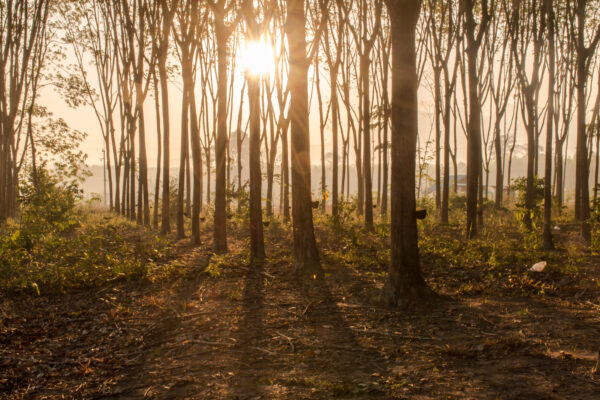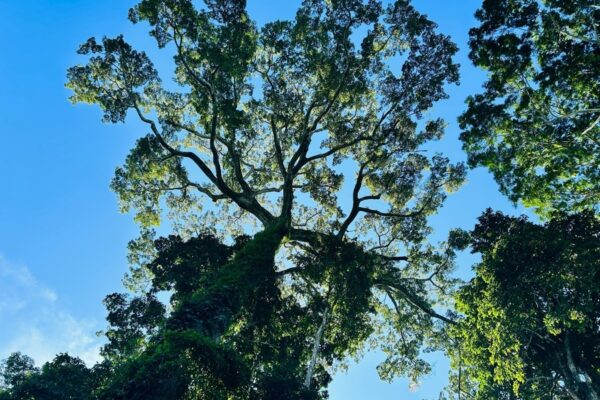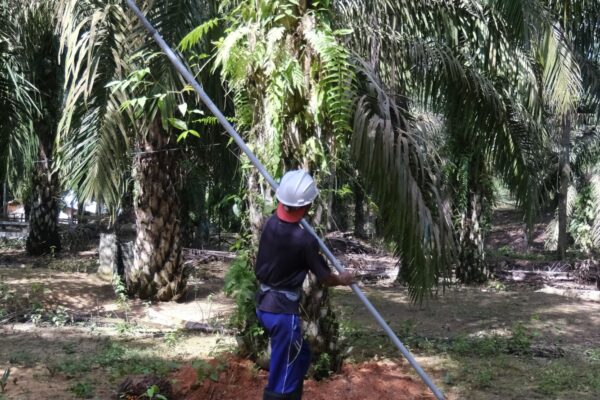6 min read
Riau Province, Indonesia—With its vast palm oil and pulp & paper plantations stretching across millions of hectares, Riau stands as Indonesia’s largest palm oil producer. But beneath the green expanse, smallholder farmers grapple with harsh realities: dwindling productivity, unpredictable incomes, and the ever-looming threat of environmental degradation. The challenge is immense, but so is the resolve of those determined to find a way forward.
In the heart of this area, Earthworm Foundation has been working to turn challenges into opportunities. We collaborate with company, raw material supply chain, NGO, or government to regenerate nature and improve people’s lives, creating replicable cases of holistic change. By weaving together sustainable land use planning, reforestation, agroforestry, and community resilience efforts, they are not just conserving nature—they are securing livelihoods.
The journey begins in the villages, where participatory land use planning (PLUP) becomes the foundation for sustainable change. It is here, in the daily lives of farmers and community leaders, that transformation takes root. Among these villages, three stand out: Batu Sasak, Mak Teduh, and Kerumutan. Each one tells a different story, but together, they illustrate the power of collaboration in building a more sustainable Riau.
For years, the people of Batu Sasak Village lived with an uneasy balance. On one side was the forest, a source of life and protection. On the other was the pressing need for economic stability. Supri, the leader of the Sei Sialang Forest Group, understood this struggle well.
“I worry,” he admitted, “if the financial situation of the community is not good, they would go back to logging and clear the land.”
It was a stark reality—without better financial prospects, conservation efforts would always be at risk. But what if protecting the forest and improving livelihoods could go hand in hand? That question led Earthworm Foundation and the community toward a two-pronged solution: eco-tourism and gambier production.

The village had always been home to a hidden gem: a picturesque waterfall. Yet, for years, tourists merely passed through Batu Sasak on their way to a neighbouring village. The potential had always been there, but it took a fresh perspective to bring it to life.
“We established a tourism awareness group,” Supri shared, “and quickly managed the path to the waterfall. Working with Earthworm made us realize that we also need to take care of and optimize our village’s potential. Planting trees will also help maintain the springs.”
Meanwhile, another opportunity lay in gambier, a local commodity long undervalued. Abdul Gani, the leader of the Gambier Community Group, knew the struggles all too well.
“Only those who have enough capital can build the processing house,” he said. “For those who can’t afford it, we had no other choice.”
Without proper facilities, gambier farmers had no option but to sell their harvested leaves to middlemen at low prices. The result? A cycle of low earnings and limited opportunities. But with Earthworm’s support, the community built a processing house, allowing farmers to process and sell gambier at fairer prices. The shift was more than economic—it was a step toward independence and sustainability.
Through these initiatives, Batu Sasak is proving that when conservation and economic development go hand in hand, both people and nature can thrive. And this is just one piece of the larger puzzle unfolding in Riau.
"Now people have to queue to use the processing house so they can process their harvest," Abdul Gani explained. “The income that we get from renting this production house will be used to build another processing house with a hydraulic system that is more efficient."

Thanks to these efforts, gambier from Batu Sasak Village is now marketed in surrounding areas, expanding its economic impact.
In the heart of Pelalawan District, nestled among vast peatlands, lies Mak Teduh Village—a community long accustomed to living with the looming threat of forest fires. Life here revolved around the land and the river, but when the village received a Social Forestry License, uncertainty clouded their path.
Suriadi, the village head, still remembers those early days of confusion. “The regulation was clear—forest areas couldn’t be cleared or turned into palm oil plantations. But what were we supposed to do with this license? How could it actually help us?” he recalled.
Earthworm began working in the area when the village had just received a Social Forestry License. Through participatory discussions, a Social Forestry Work Plan was crafted—one that would protect the forest while unlocking new ways to sustain this community.
The plan was ambitious: forest conservation, ecotourism with river tracking adventures, and critical measures to fight illegal logging. But perhaps the most life-changing initiative came for the village’s fishers. Earthworm helped to introduce floating net cages—an idea that sparked hope in the hearts of those who had watched their river’s fish population dwindle.
Paremak, a fisherman and member of the Sungai Bobak Farmer Group, beamed with pride as he described the shift. “We used to catch fish, but there were fewer and fewer. Now, we have our own fishponds, and we’ve learned so much. It’s not just about income—by releasing fish back into the river, we’re also helping bring life back to our waters.”

What began as an uncertain journey had turned into a story of resilience. Mak Teduh was no longer just a village navigating restrictions—it was a community shaping its own sustainable future.
Under the relentless tropical sun, the fields of Kerumutan Subdistrict stretched as far as the eye could see—dominated by oil palm plantations that had long shaped the landscape. But within this expanse was a small group of farmers, determined to carve out a path where nature and livelihoods could flourish side by side.

At the heart of this transformation was Abdul Gani, the Head of Kerumutan. "We have 22 hectares of unproductive land," he told the farmers. "What if we bring life back to it?"
With the support of Earthworm, the community embarked on a journey of trials. They learned to practice intercropping—integrating hard crop trees with horticultural plants, restoring soil health, and creating a sustainable source of income.
Jajuli, a member of the Tumbuh Berseri Farmer Group, still remembers the days when farming felt like a losing battle. "Before, we barely made enough," he recalled. "Our knowledge was limited, and so was our harvest. But after Earthworm’s training and hands-on support, everything changed." The fields that once yielded only small harvests soon began producing in abundance.
"Now, our crops don’t just feed our families," Jajuli said, his face lighting up with pride. "We sell to neighbouring villages. What used to be mere kilograms has turned into tonnes. Our production has increased by 70%!"

The experiences from Batu Sasak, Mak Teduh, and Kerumutan Villages illustrate the transformative potential of integrated sustainability efforts. Conservation initiatives, combined with economic empowerment, are helping communities in Riau build more resilient and sustainable livelihoods.
These successes proved a powerful truth—when conservation, land management, and economic growth align, communities don’t have to choose between nature and livelihood. They can have both.
But the work isn’t finished. The vision extends beyond these villages. If these sustainable models take root across Riau and beyond, they could reshape landscapes, empower more communities, and create a ripple effect of environmental and economic stability throughout Indonesia.
None of this would have been possible without the support of the Walmart Foundation, which helped advance these efforts alongside brands and companies such as LVMH, Nestlé, Reckitt, PZ Cussons, APRIL, Colgate-Palmolive, Givaudan, and Target.


